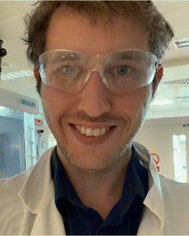Introduction to synthetic electrochemistry: new tricks for an old discipline
Kevin
Lam
 a,
Shelley D.
Minteer
a,
Shelley D.
Minteer
 b and
Darren L.
Poole
b and
Darren L.
Poole
 *c
*c
aSchool of Science, The University of Greenwich, Chatham Maritime, Chatham, Kent ME4 4TB, UK
bDepartment of Chemistry, The University of Utah, Salt Lake City, Utah 84112, USA
cDiscovery High-Throughput Chemistry, Medicinal Chemistry, GSK Medicines Research Centre, Stevenage, SG1 2NY, UK. E-mail: darren.l.poole@gsk.com
This rapid growth in the popularity of synthetic electrochemistry has brought numerous advances, not only in the identification of improved and more sustainable conditions for known reactions, including through the renewable generation of electricity, but also in the ability to harness electrons to access new chemical space. Through both of these paradigms, significant advances have been made in numerous fields, including the total synthesis of natural products, the synthesis of materials, functionalisation of biomolecules and bioelectrocatalysis, and in the synthesis of fine chemicals, agrochemicals and pharmaceuticals in industry.
We are delighted to present this themed collection in Organic & Biomolecular Chemistry on Synthetic Electrochemistry, covering key advances in the field, including the development of new synthetic methods, and reviews which will be of interest to both those experienced in synthetic electrochemistry, and those looking to develop their understanding of the field.
Electrochemical methods have proven their utility in the synthesis of natural products since Corey's synthesis of pentacyclosqualene in 1958.5 Munda et al. (https://doi.org/10.1039/D1OB02115J) provide a holistic overview of the application of electrochemistry in the synthesis of a range of complex alkaloids. Further advances in this field are presented by Shaw and coworkers (https://doi.org/10.1039/D1OB01463C) who present an electrochemical proton-coupled electron transfer for the dimerisation of oxindoles in the total synthesis of (±)-folicanthine.
Halogens provide key functional handles across synthetic chemistry. Scheide et al. (https://doi.org/10.1039/D0OB02459G) present a comprehensive review of electrochemical methods for introduction of sp2 and sp3 fluorine, chlorine, bromine and iodine substituents. Seitz and Wirth (https://doi.org/10.1039/D1OB01302E) demonstrate bromofunctionalisation of alkenes utilising the anodic oxidation of HBr to circumvent the need for Br2 or stoichiometric oxidations. This work highlights the utility of flow chemistry in facilitating the handling of reactive species, and in enabling further scale up. Elsherbini and Moran (https://doi.org/10.1039/D1OB00457C) report the synthesis of unsymmetrical cyclic and acyclic diaryliodonium salts by anodic oxidation, obviating the need for stoichiometric chemical oxidants, with a scalable procedure which benefits from a recyclable solvent system.
Functional group transformations are key steps in many synthetic routes, and electrochemistry can provide both alternative and more sustainable options to these, alongside opening up previously inaccessible disconnections. Chen et al. (https://doi.org/10.1039/D1OB00420D) highlight the range of possible decarboxylative electrochemical functionalisations in their review on recent progress in electrochemical synthesis involving carboxylic acids. The reduction of benzoic acids to cyclohexane carboxylic acids typically requires the use of stoichiometric metal reductants or expensive catalysts. Fukazawa et al. (https://doi.org/10.1039/D1OB01197A) report a method utilising a PtRu cathode for the electrocatalytic reduction of benzoic acids in a proton-exchange membrane reactor. Chang et al. (https://doi.org/10.1039/D1OB00077B) report a scalable chemoselective reduction of nitroarenes with gaseous ammonia as a reductant to afford azoxybenzenes, azobenzenes, hydrazines and anilines via stepwise cathodic reduction. Zhang et al. (https://doi.org/10.1039/D0OB02444A) report a novel electrochemical alternative to the Darzens condensation, through a peroxide-free oxidative coupling of ketones and aldehydes mediated by potassium iodide, to furnish α,β-epoxy ketones.
New disconnections for the synthesis of heterocycles, and access to previously unexplored chemical space are of paramount importance in the development of new medicines and agrochemicals. Hou et al. (https://doi.org/10.1039/D1OB01644J) utilise a novel tetraarylhydrazine mediator in an intramolecular {3 + 2} heteroannulation to access imidazo-fused bicyclic heteroaromatics, a key component of a number of marketed pharmaceuticals. Zhang et al. (https://doi.org/10.1039/D1OB00079A) have developed an oxidant-free, cascade radical synthesis of 3-sulfonylated benzothiophenes via anodic oxidation of sulfinate salts from readily available 2-alkynyl thiophenol derivatives. Further demonstrating the benefits of continuous flow technology in electrochemical synthesis, Bian et al. (https://doi.org/10.1039/D1OB00236H) present a novel disconnection for the synthesis of selenium-substituted iminoisobenzofurans.
The application of synthetic electrochemical techniques to the synthesis and functionalisation of biomolecules is a rapidly expanding area. Stricker and coworkers (https://doi.org/10.1039/D1OB00414J) report the modular synthesis of foldable flavin-peptide conjugates and investigate both the folding and redox characteristics of the conjugates, opening up potential future avenues for asymmetric catalysis and electrode functionalisation.
As is made evident by the range of articles in this themed collection, synthetic electrochemistry has applications across a remarkable breadth of scientific endeavours. We are grateful to all the authors for their contributions to the collection, and are excited and optimistic for the future growth of synthetic electrochemistry, and the opportunities it will continue to provide to streamline the synthesis of functional molecules, and open up exciting new areas of chemical space.
References
- E. J. Horn, B. R. Rosen and P. S. Baran, ACS Cent. Sci., 2016, 2, 302 CrossRef CAS PubMed; M. Yan, Y. Kawamata and P. S. Baran, Chem. Rev., 2017, 21, 13230 CrossRef PubMed.
- J. Rein, J. R. Annand, M. K. Wismer, J. Fu, J. C. Siu, A. Klapars, N. A. Strotman, D. Kalyani, D. Lehnherr and S. Lin, ACS Cent. Sci., 2021, 7, 1347 CrossRef CAS PubMed.
- T. Noël, Y. Cao and G. Laudadio, Acc. Chem. Res., 2019, 52, 2858 CrossRef PubMed.
- S. Möhle, M. Zirbes, E. Rodrigo, T. Gieshoff, A. Wiebe and S. Waldvogel, Angew. Chem., Int. Ed., 2018, 57, 6018 CrossRef CAS PubMed; C. Kingston, M. D. Palkowitz, Y. Takahira, J. C. Vantourout, B. K. Peters, Y. Kawamata and P. S. Barab, Acc. Chem. Res., 2020, 53, 72 CrossRef PubMed; C. Schotten, T. P. Nicholls, R. A. Bourne, N. Kapur, B. N. Nguyen and C. E. Willans, Green Chem., 2020, 22, 3358 RSC.
- E. J. Corey and R. R. Sauers, J. Am. Chem. Soc., 1959, 81, 1739 CrossRef CAS.
| This journal is © The Royal Society of Chemistry 2023 |



